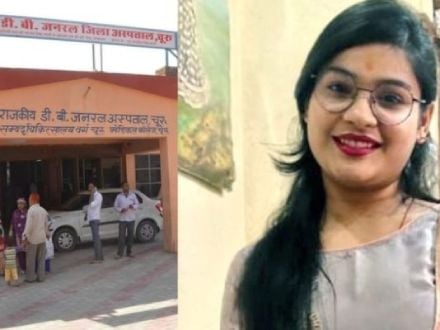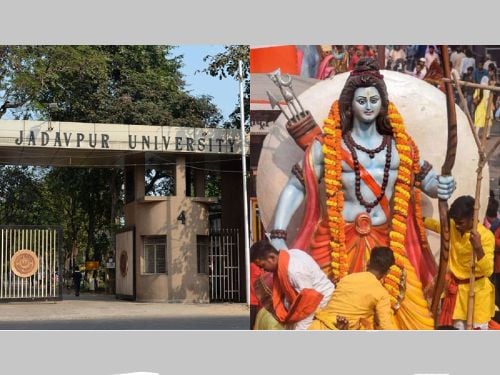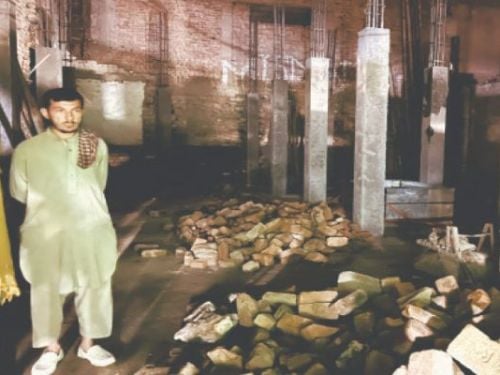Paush Krushna Chaturthi, Kaliyug Varsha 5111
By Dr Vijaya Rajiva
The historic district of Kanyakumari in the state of Tamil Nadu is now the center of another struggle by the Hindus against the combined might of the Communist- Islamic- Christian cabal in power both in the state of Kerala and Tamil Nadu.
In this instance the Hindu villagers are locked in a non violent battle against the police who as in every other case, are on the side of whichever cabal is in power. Here, in the village of Athikaatuvillai , the residents have for centuries taken out a procession for the Goddess Kanyakumari (an avatar of Parvathi) following a certain route. The small Christian population there are now opposing this by claiming that the lane is private property and that it belongs to the Church. The lane is part of public land (the Panchayat) and the signboards say so quite clearly.
Neverthless, the Christians have decided to be obdurate. The Hindus took out the procession with women very much in the forefront, since the Goddess is their special deity. Photographs show the brutality of the police, with one graphic picture of a bleeding head. Women were also beaten up. This can be viewed in short videos, especially the last of the series of four . (See the current issue of Haindava Keralam, ‘ The Agony of Hindus in Kanyakumari ‘ ).
This incident is not particularly surprising since the Christian Church in India has become emboldened by the fact that an Italian Catholic is at the centre of power in New Delhi ( an individual who seems to be either indifferent to or perhaps even hostile to Hindu sentiment, and surrounds herself with Christian advisors and Muslim aides. ( Was it not the Minister of Railways who wondered out aloud whether it was necessary to light lamps during an inauguration ceremony ? ) . There is also a Christian fundamentalist dimension to this problem with such outfits as World Life Vision, who are behind the scurrilous literature on Hinduism and the attempts at conversion in various parts of India, especially the Mangalore region in Karnataka. Add to this two other major actors : Pat Robertson of the U.S.A. who has publicly stated that in the next 10 years 100 million Indians must be converted to Christianity, and the Catholic Pope who on his visit to India had proclaimed that India, will be the next target for the Church, for the harvesting of souls ! Funds are sent generously to India to build churches, even where the local Christian population is minuscule. And quite blatantly sent to aid in conversions.
It is well known that many secessionist movements in the North East of India have been fuelled by Christian missionaries. And the process of conversion of any and everybody who is vulnerable to Christian propaganda goes on apace. What one asks is the agenda here ?
But the fight back from the Hindus has already begun. Why is this important ? India is the last of the holdouts against imperial proselytisation. It has always been so and no doubt will continue to be so. This is not only because of the resilience of Hinduism and possibly its universal world view (as opposed to the particularistic world view of the two proselytising religions, Christianity and Islam) but because Hindusim is the ancestral, indigenous religion of almost one billion people of whom more than 800 million live in the Indian subcontinent itself.
Hinduism is also very much a modern ecological religion. Kanyakumari is a case in point. It is among the many centers of cosmic power (associated with the female principle as the creative principle of the universe) that dot the Indian landscape. It has a variety of ecosystems which are worshipped by the Hindus. This is true both of the everyday Hindu and the upper classes.
This emphasis on the ecological environment can be traced back to the four Vedas, especially the Rig Veda whose 10008 plus hymns are all invocations to the forces of Nature. The famous statement by the 17th century Dutch philosopher Spinoza , God or Nature is most applicable to the Rig Vedic hymns. While the Rig Veda is much admired today all over the world, this was not always the case. Max Mueller, the famous scholar in Indic studies (or Indology as it used to be called) certainly admired the Sanskrit classics and the Vedas. Neverthless, his motives were not always academic or altruistic.
Recent publication of his correspondence shows that his aim was the conversion of the people of the subcontinent to Christianity, which in his estimation was superior to Hinduism.
This was an imperial idea, not shared by all German scholars or philosophers, notably Schopenhauer. But certainly the 19th century German philosopher Hegel believed that history was on a certain eschatological trajectory and his philosophy of history (which influenced the young Marx among others in its historical – progression theory ) envisaged a culmination of the historical process in the ideal modern Christian state. True, both Max Mueller and Hegel were not crudely condescending towards Hinduism, but their views were a reflection of the dogmatic and proselytising views of the Christian tradition, which today can be seen in the crude proselytisation of a Pat Robertson or even some homegrown Indian ministers ranting at the pulpit.
It fitted in neatly with the colonization project of the European powers. In the case of India, missionary activity suited the colonial exploitation of native peoples because in a sense they were like the birds and beasts of creation, to be under man’s dominion and for his enjoyment . (The Bible had told them that the birds and beasts of creation were under man’s dominion in the chapter on Genesis). Not to mention the wealth that awaited to be plundered.
Marx, ofcourse , was also influenced by his own brand of humanism which he derived from the Greek Sophist philosopher, Protagoras , whose maxim was : Man is the measure of all things. Hence, Marx while he condemned in no uncertain terms the colonial exploitation of India, also said that British rule benefitted India where man who should be the master of Nature fell down to worship Sabala the cow and Hanuman the monkey. This limited humanism also has soaked into the consciousness of Indian Communists, who are congenitally unable to team up with Hinduism, even to further their own goals of social change.
However, both the colonial and the missionary project encountered unexpected obstacles. They had encountered a vastly superior civilization in India and one which had been around for several millennia before the advent of Christianity or the modern industrial revolution .
This resistance occurred because the Hindus saw the land as Punya Bhumi or Sacred Land not to be exploited but to be worshipped, and their philosophical and religious tradition was profound both in itself and in its syncreticism. ‘The sacred books of the Hindus ‘ was not simply a polite phrase, it expressed a vast and diverse tradition of learning, in the arts and sciences and religious and philosophical thought. It was not the domination (alleged) of the Brahmanical or upper castes, that held the country together. It was the worship of the cosmic powers bequeathed from Vedic times that made it unnecessary for any worshipper to move to a religion that limited his/her horizon to the worship of one god whom the proselytizer claimed to be the one and only god. Hence, even the everyday Hindu had access to a variety of dimensions of worship which are lacking in the proselytising faiths. The diverse modes of worship held the various communities together.
The underlying principle here is the worship of cosmic powers and the worship of these powers as being localized in the land with its many cosmic centers of power, and the worship of the personification of these powers in the form of Bharata Mata (shown as a woman). This was and still is unique to Hinduism. This conjunction of the cosmic and the earthly provided the context in which Hindus would call their land Punya Bhumi or sacred land. Down the millennia it has been a powerful cohesive force for Hindus all over the subcontinent.
And so except in rare instances, a Hindu would not voluntarily convert to a dogmatic faith, except ofcourse under duress, such as economic distress, bribery, force and fraud. Hence, also , the return now of many of the lower castes to their ancestral faith, after the first flush of conversion. In many places, the lower castes found that after conversion they were still part of a hierarchical caste system where they sat in separate pews in Church apart from the upper caste converts.
In Kanyakumari, during the recent incident, women played a significant role in contesting the decision by the authorities to prohibit them from taking out the procession of Kanyakumari Amman, their deity. They and their ancestors had worshipped Kanyakumari since time immemorial and they had carried her image along the same route for centuries. The women declared that they were prepared to continue that tradition by making any sacrifice necessary, engaging in any non violent practice to continue with their indigenous and ancestral modes of worship.
Kudos to these women of Kanyakumari, kudos to the everyday Hindu men and women of the place !
Vande Mataram !
Source: Haindava Keralam
Also See
 |
Protest against defamation of Hindu Deities & Icons |
 |
Save temples from Anti-Hindus
Temples are the centres of Hindu Dharma. Anti Hindu forces like Muslims, Congress, Christians has constantly targetted them. HJS is fighting against these forces. |

 Rajasthan: Woman found hanging at a beauty parlour, Arshad, 3 others booked
Rajasthan: Woman found hanging at a beauty parlour, Arshad, 3 others booked Jadavpur Univ revokes permission to celebrate Ram Navami on campus after granting it
Jadavpur Univ revokes permission to celebrate Ram Navami on campus after granting it Andhra Pradesh: Farooq kills mentally challenged Hindu man for insurance money
Andhra Pradesh: Farooq kills mentally challenged Hindu man for insurance money Pakistan: Ancient Hindu temple in Khyber Pakhtunkhwa demolished for commercial complex
Pakistan: Ancient Hindu temple in Khyber Pakhtunkhwa demolished for commercial complex Bihar: Goddess Bhagavati Temple in Araria vandalised and deities damaged
Bihar: Goddess Bhagavati Temple in Araria vandalised and deities damaged Vadodara: Beef supplier Imran Qureshi arrested in beef-stuffed samosa case
Vadodara: Beef supplier Imran Qureshi arrested in beef-stuffed samosa case